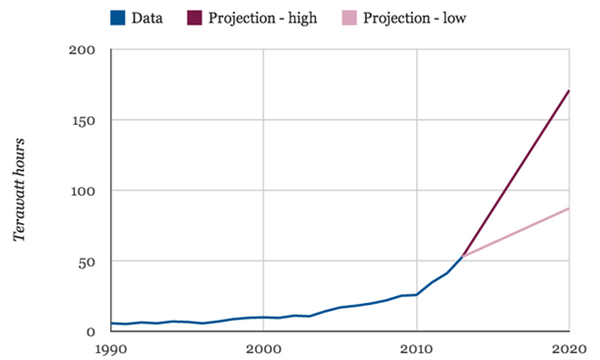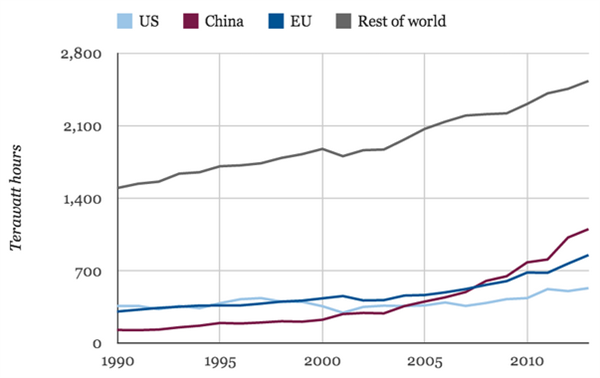Simon Evans
28.08.2014 | 1:00pmUK wind power shattered records last week, spinning out 22 per cent of electricity demand for a day. One in five of our morning cups of tea was renewably-powered, if you like.
Sound familiar? It should, because renewables keep breaking records. In 2013 records were smashed. The same was true in 2010, 2011 and 2012.
In fact, the amount of power generated by renewable sources of electricity in the UK was record breaking through much of the 1990sâ?¦ and in every single year since 2004 (graph, below).
 Source: BP Statistical Review of World Energy 2014
Source: BP Statistical Review of World Energy 2014
This shouldn’t come as a surprise. We’ve been building a lot of windfarms, solar panels and biomass conversions recently.
Back when Britpop was cool in the early 90s a measly 2 per cent of UK electricity came from renewables. Almost all of that was from hydropower. By 2013, as Miley Cyrus twerked her way to the top of the charts, the UK got 15 per cent of its electricity from renewables, with more than half of it coming from windfarms.

Helpful infographic by Carbon Brief. Miley Cyrus / Shutterstock
The hot streak for renewable records in the UK is set to continue.
Even under the lowest projections from the Department from Energy and Climate Change (DECC) we should continue to see record-breaking levels of renewable electricity until the end of the decade (pink line, below).
And if every renewable technology meets the most optimistic DECC projections then renewable electricity output will triple by 2020 (purple line).

Source: BP Statistical Review of World Energy 2014 and Carbon Brief analysis of DECC’s renewable energy roadmap and electricity market reform delivery plan.
Despite this undeniable progress, the UK’s 63 million inhabitants (0.9 per cent of the world’s population) use only about 1.5 per cent of the world’s electricity. Unless the rest of the world joins in, the UK decarbonising isn’t going to change much.
Luckily we’re not alone. The US (light blue line, below) got a record 14 per cent of its power from renewables in the first half of 2014. Other European countries (dark blue), China (purple) and the rest of the world (grey) have also been busy smashing renewable records.

Source: BP Statistical Review of World Energy 2014
China overtook the US in 2005 and the EU in 2008, and is now the undisputed global emperor of renewable electricity generation. It’s lead is set to grow. Over the next 20 years China is expected to install more renewable capacity than the combined green energy additions of the US, EU and Japan put together.
At a global level this will also continue until at least 2020, according to a new report from the International Energy Agency (IEA). It expects renewable power output to surge from 5,070 terawatt hours of electricity in 2013 to 7,310 terawatt hours in 2020. That’s a 45 per cent increase at an annual growth rate of over five per cent.
So are we actually decarbonising?
In the UK, the answer is yes – slowly. Electricity consumption has been falling since around 2005 (purple area, below left). And at the same time, as we’ve already seen, renewable electricity generation has increased (blue area, below left).
But comparing renewables against other forms of electricity generation (below right), you can see there’s still a long way to go if the UK wants to get most of its electricity from renewable sources.

Source: BP Statistical Review of World Energy 2014
There’s a broadly similar story across the EU, with electricity demand falling slightly (purple area, below left) and renewables taking a growing share of the mix (blue area, below right). About 25 per cent of EU electricity comes from renewables – including hydro and biomass.

Source: BP Statistical Review of World Energy 2014
But when it comes to the world as a whole, something different has been happening.
Global renewable electricity output has more than doubled since the early 90s (blue area, below left). But global electricity demand has also shot up. (Purple area, below left). That’s because rapidly developing countries like China have built huge numbers of fossil-fired power stations to power growing cities and manufacturing exports.
This means the renewable share of global electricity generation (blue area, below right) hasn’t really changed much over the past 20 years. When Blur was topping the charts in 1994 the world’s electricity supply was 20 per cent renewable. Today the figure is 22 per cent.

Source: BP Statistical Review of World Energy 2014
While not forgetting that electricity accounts for only a small part of our overall energy use, it’s true that a renewable revolution of sorts really is under way.
It’s just that it’s happening at the same time as a revolution in living standards, with billions of new consumers hooking up to the electricity grid and millions more buying the latest power-hungry flat-screen TVs, made in China.
The IEA expects these twin revolutions to continue. Even though renewable power output will expand rapidly, its share of total electricity generation around the world will reach just 26 per cent in 2020.
Nevertheless, we can expect renewables to continue to demolish records – much like a wrecking ball. If we want renewables to help limit global temperatures to no more than two degrees, there’s no other way.

